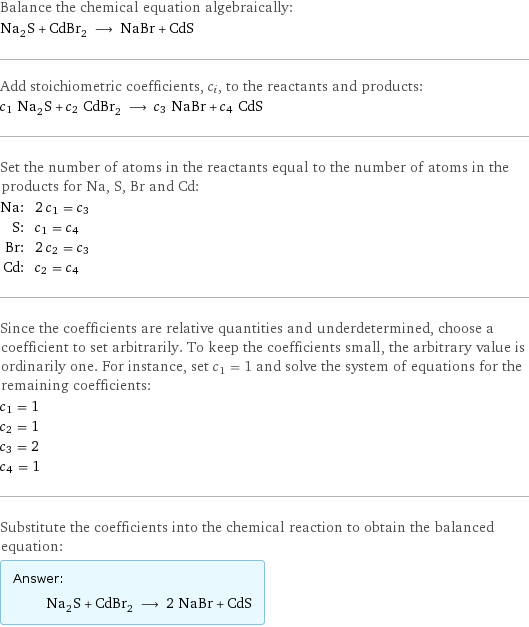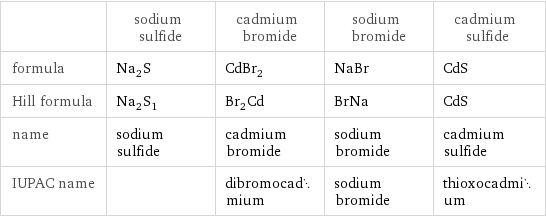Input interpretation

Na_2S sodium sulfide + CdBr_2 cadmium bromide ⟶ NaBr sodium bromide + CdS cadmium sulfide
Balanced equation

Balance the chemical equation algebraically: Na_2S + CdBr_2 ⟶ NaBr + CdS Add stoichiometric coefficients, c_i, to the reactants and products: c_1 Na_2S + c_2 CdBr_2 ⟶ c_3 NaBr + c_4 CdS Set the number of atoms in the reactants equal to the number of atoms in the products for Na, S, Br and Cd: Na: | 2 c_1 = c_3 S: | c_1 = c_4 Br: | 2 c_2 = c_3 Cd: | c_2 = c_4 Since the coefficients are relative quantities and underdetermined, choose a coefficient to set arbitrarily. To keep the coefficients small, the arbitrary value is ordinarily one. For instance, set c_1 = 1 and solve the system of equations for the remaining coefficients: c_1 = 1 c_2 = 1 c_3 = 2 c_4 = 1 Substitute the coefficients into the chemical reaction to obtain the balanced equation: Answer: | | Na_2S + CdBr_2 ⟶ 2 NaBr + CdS
Structures

+ ⟶ +
Names

sodium sulfide + cadmium bromide ⟶ sodium bromide + cadmium sulfide
Reaction thermodynamics
Enthalpy

| sodium sulfide | cadmium bromide | sodium bromide | cadmium sulfide molecular enthalpy | -364.8 kJ/mol | -316.2 kJ/mol | -361.1 kJ/mol | -161.9 kJ/mol total enthalpy | -364.8 kJ/mol | -316.2 kJ/mol | -722.2 kJ/mol | -161.9 kJ/mol | H_initial = -681 kJ/mol | | H_final = -884.1 kJ/mol | ΔH_rxn^0 | -884.1 kJ/mol - -681 kJ/mol = -203.1 kJ/mol (exothermic) | | |
Gibbs free energy

| sodium sulfide | cadmium bromide | sodium bromide | cadmium sulfide molecular free energy | -349.8 kJ/mol | -296.3 kJ/mol | -349 kJ/mol | -156.5 kJ/mol total free energy | -349.8 kJ/mol | -296.3 kJ/mol | -698 kJ/mol | -156.5 kJ/mol | G_initial = -646.1 kJ/mol | | G_final = -854.5 kJ/mol | ΔG_rxn^0 | -854.5 kJ/mol - -646.1 kJ/mol = -208.4 kJ/mol (exergonic) | | |
Equilibrium constant
![Construct the equilibrium constant, K, expression for: Na_2S + CdBr_2 ⟶ NaBr + CdS Plan: • Balance the chemical equation. • Determine the stoichiometric numbers. • Assemble the activity expression for each chemical species. • Use the activity expressions to build the equilibrium constant expression. Write the balanced chemical equation: Na_2S + CdBr_2 ⟶ 2 NaBr + CdS Assign stoichiometric numbers, ν_i, using the stoichiometric coefficients, c_i, from the balanced chemical equation in the following manner: ν_i = -c_i for reactants and ν_i = c_i for products: chemical species | c_i | ν_i Na_2S | 1 | -1 CdBr_2 | 1 | -1 NaBr | 2 | 2 CdS | 1 | 1 Assemble the activity expressions accounting for the state of matter and ν_i: chemical species | c_i | ν_i | activity expression Na_2S | 1 | -1 | ([Na2S])^(-1) CdBr_2 | 1 | -1 | ([CdBr2])^(-1) NaBr | 2 | 2 | ([NaBr])^2 CdS | 1 | 1 | [CdS] The equilibrium constant symbol in the concentration basis is: K_c Mulitply the activity expressions to arrive at the K_c expression: Answer: | | K_c = ([Na2S])^(-1) ([CdBr2])^(-1) ([NaBr])^2 [CdS] = (([NaBr])^2 [CdS])/([Na2S] [CdBr2])](../image_source/c4b2f74319a80489978a52966be4bbf9.png)
Construct the equilibrium constant, K, expression for: Na_2S + CdBr_2 ⟶ NaBr + CdS Plan: • Balance the chemical equation. • Determine the stoichiometric numbers. • Assemble the activity expression for each chemical species. • Use the activity expressions to build the equilibrium constant expression. Write the balanced chemical equation: Na_2S + CdBr_2 ⟶ 2 NaBr + CdS Assign stoichiometric numbers, ν_i, using the stoichiometric coefficients, c_i, from the balanced chemical equation in the following manner: ν_i = -c_i for reactants and ν_i = c_i for products: chemical species | c_i | ν_i Na_2S | 1 | -1 CdBr_2 | 1 | -1 NaBr | 2 | 2 CdS | 1 | 1 Assemble the activity expressions accounting for the state of matter and ν_i: chemical species | c_i | ν_i | activity expression Na_2S | 1 | -1 | ([Na2S])^(-1) CdBr_2 | 1 | -1 | ([CdBr2])^(-1) NaBr | 2 | 2 | ([NaBr])^2 CdS | 1 | 1 | [CdS] The equilibrium constant symbol in the concentration basis is: K_c Mulitply the activity expressions to arrive at the K_c expression: Answer: | | K_c = ([Na2S])^(-1) ([CdBr2])^(-1) ([NaBr])^2 [CdS] = (([NaBr])^2 [CdS])/([Na2S] [CdBr2])
Rate of reaction
![Construct the rate of reaction expression for: Na_2S + CdBr_2 ⟶ NaBr + CdS Plan: • Balance the chemical equation. • Determine the stoichiometric numbers. • Assemble the rate term for each chemical species. • Write the rate of reaction expression. Write the balanced chemical equation: Na_2S + CdBr_2 ⟶ 2 NaBr + CdS Assign stoichiometric numbers, ν_i, using the stoichiometric coefficients, c_i, from the balanced chemical equation in the following manner: ν_i = -c_i for reactants and ν_i = c_i for products: chemical species | c_i | ν_i Na_2S | 1 | -1 CdBr_2 | 1 | -1 NaBr | 2 | 2 CdS | 1 | 1 The rate term for each chemical species, B_i, is 1/ν_i(Δ[B_i])/(Δt) where [B_i] is the amount concentration and t is time: chemical species | c_i | ν_i | rate term Na_2S | 1 | -1 | -(Δ[Na2S])/(Δt) CdBr_2 | 1 | -1 | -(Δ[CdBr2])/(Δt) NaBr | 2 | 2 | 1/2 (Δ[NaBr])/(Δt) CdS | 1 | 1 | (Δ[CdS])/(Δt) (for infinitesimal rate of change, replace Δ with d) Set the rate terms equal to each other to arrive at the rate expression: Answer: | | rate = -(Δ[Na2S])/(Δt) = -(Δ[CdBr2])/(Δt) = 1/2 (Δ[NaBr])/(Δt) = (Δ[CdS])/(Δt) (assuming constant volume and no accumulation of intermediates or side products)](../image_source/68063f373db5bd0a4ba4c9cfac6c9281.png)
Construct the rate of reaction expression for: Na_2S + CdBr_2 ⟶ NaBr + CdS Plan: • Balance the chemical equation. • Determine the stoichiometric numbers. • Assemble the rate term for each chemical species. • Write the rate of reaction expression. Write the balanced chemical equation: Na_2S + CdBr_2 ⟶ 2 NaBr + CdS Assign stoichiometric numbers, ν_i, using the stoichiometric coefficients, c_i, from the balanced chemical equation in the following manner: ν_i = -c_i for reactants and ν_i = c_i for products: chemical species | c_i | ν_i Na_2S | 1 | -1 CdBr_2 | 1 | -1 NaBr | 2 | 2 CdS | 1 | 1 The rate term for each chemical species, B_i, is 1/ν_i(Δ[B_i])/(Δt) where [B_i] is the amount concentration and t is time: chemical species | c_i | ν_i | rate term Na_2S | 1 | -1 | -(Δ[Na2S])/(Δt) CdBr_2 | 1 | -1 | -(Δ[CdBr2])/(Δt) NaBr | 2 | 2 | 1/2 (Δ[NaBr])/(Δt) CdS | 1 | 1 | (Δ[CdS])/(Δt) (for infinitesimal rate of change, replace Δ with d) Set the rate terms equal to each other to arrive at the rate expression: Answer: | | rate = -(Δ[Na2S])/(Δt) = -(Δ[CdBr2])/(Δt) = 1/2 (Δ[NaBr])/(Δt) = (Δ[CdS])/(Δt) (assuming constant volume and no accumulation of intermediates or side products)
Chemical names and formulas

| sodium sulfide | cadmium bromide | sodium bromide | cadmium sulfide formula | Na_2S | CdBr_2 | NaBr | CdS Hill formula | Na_2S_1 | Br_2Cd | BrNa | CdS name | sodium sulfide | cadmium bromide | sodium bromide | cadmium sulfide IUPAC name | | dibromocadmium | sodium bromide | thioxocadmium
Substance properties

| sodium sulfide | cadmium bromide | sodium bromide | cadmium sulfide molar mass | 78.04 g/mol | 272.22 g/mol | 102.89 g/mol | 144.47 g/mol phase | solid (at STP) | solid (at STP) | solid (at STP) | solid (at STP) melting point | 1172 °C | 567 °C | 755 °C | 1400 °C boiling point | | 863 °C | 1396 °C | density | 1.856 g/cm^3 | 5.19 g/cm^3 | 3.2 g/cm^3 | 4.82 g/cm^3 solubility in water | | soluble | soluble |
Units
